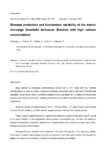Mostrar o rexistro simple do ítem
Biomass production and biochemical variability of the marine microalga Dunaliella tertiolecta (Butcher) with high nutrient concentrations
| dc.contributor.author | Fábregas, Jaime | |
| dc.contributor.author | Herrero, Concepción | |
| dc.contributor.author | Abalde, Julio | |
| dc.contributor.author | Cabezas, Buenaventura | |
| dc.date.accessioned | 2015-09-09T15:46:15Z | |
| dc.date.available | 2015-09-09T15:46:15Z | |
| dc.date.issued | 1986 | |
| dc.identifier.citation | Fabregas J, Herrero C, Abalde J, Liaño R, Cabezas B. Biomass production and biochemical variability of the marine microalga Dunaliella tertiolecta (Butcher) with high nutrient concentrations. Aquaculture. 1986;53(3-4):187-99 http://dx.doi.org/10.1016/0044-8486(86)90350-9 | es_ES |
| dc.identifier.issn | 0044-8486 | |
| dc.identifier.uri | http://hdl.handle.net/2183/14912 | |
| dc.description.abstract | Mass cultures of Dunaliella tertiolecta were carried out in 10-l flasks with four nutrient concentrations in order to obtain a maximum biomass production and to find out its biochemical variability. Using these cultural conditions equations were calculated by a multiple non-linear least squares regression of order four, enabling predictions to be made of growth kinetics and chemical composition. Maximum cellular densities between 12.45 × 106 and 14.23 × 106 cells/ml were obtained with 4, 8 and 16 mM of NaNO3. Growth velocity ranged between 0.50 and 0.61 doublings/day. Protein content reached maximum values in the stationary phase of 442 μg/ml and 31 pg/cell at 16 mM of NaNO3. In the logarithmic phase protein concentration per cell was not related to nutrient concentration. Maximum efficiencies of transformation from nitrate to protein were 100%, obtained at 2 and 4 mM of NaNO3. Chlorophyll a/cell reached values between 1.03 and 1.95 pg/cell in the stationary phase. There was no relationship between nutrient concentration and chlorophyll a/cell in the logarithmic phase, the values for the different nutrient concentrations being very similar. The maximum value of carbohydrates, 185 μg/ml, was obtained with 4 mM of NaNO3. Carbohydrates/cell reached the maximum values of 8.94 and 10.05 pg/cell with 8 and 16 mM of NaNO3, respectively, in the stationary phase. RNA/cell ranged from 4.28 to 5.40 pg/cell in the logarithmic phase and from 4.72 to 5.80 pg/cell in the stationary. The level of DNA/cell was constant in all the nutrient concentrations tested and in both growth phases, and ranged from 0.05 to 0.12 pg/cell. Great variability in the chemical composition of D. tertiolecta has been shown. Growth in mass cultures is closely coupled to changes in nutrient concentration, and variations occur in protein, chlorophyll a, carbohydrates and RNA content, showing differences of 197%, 255%, 142% and 150%, respectively. This biochemical variability must have a marked effect on the value of this microalga as source of single cell protein, chemicals or as feed in mariculture. | es_ES |
| dc.language.iso | eng | es_ES |
| dc.publisher | Elsevier Science Editors | es_ES |
| dc.relation.uri | http://dx.doi.org/10.1016/0044-8486(86)90350-9 | es_ES |
| dc.subject | Dunaliella tertiolecta | es_ES |
| dc.subject | Nutrient concentrations | es_ES |
| dc.subject | Biomass production | es_ES |
| dc.subject | Biochemical variability | es_ES |
| dc.subject | Marine microalgae | es_ES |
| dc.subject | Cultures | es_ES |
| dc.title | Biomass production and biochemical variability of the marine microalga Dunaliella tertiolecta (Butcher) with high nutrient concentrations | es_ES |
| dc.type | info:eu-repo/semantics/article | es_ES |
| dc.rights.access | info:eu-repo/semantics/openAccess | es_ES |






